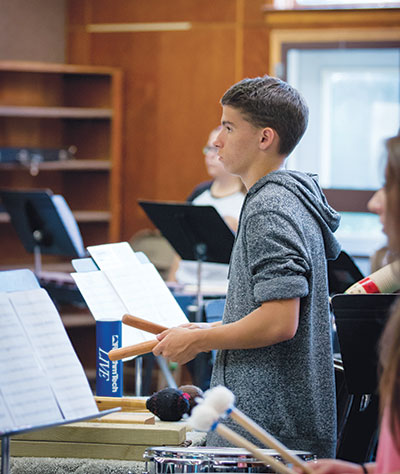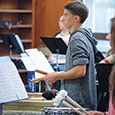
photo courtesy of International Music Camp
Many teachers have experienced percussionists playing ahead of or behind the beat while not watching the director, losing their place in the music and having a hard time getting back on track, or missing a major entrance as they careen towards an instrument carrying an armful of mallets and music during a rehearsal or performance. Percussionists face challenges that wind and string players do not when setting up and reading their music, so directors must devise creative solutions to help them make the most of this aspect of their ensemble experience. Here are four common music-reading pitfalls your percussionists may face and examples of how to overcome them.
Score Parts
Score parts show all percussionists what the entire section is playing. Given that snare drum, crash cymbals, and xylophone parts, for example, tend to be one player per instrument, this method of notation can help everyone stay on track by checking in on each other’s cues. It also offers percussionists a view of the big picture throughout the piece so that directors can help them see how the parts interact. Students may play more cohesively as a section with these parts because the work of all players is on display for everyone.
Several challenges arise when reading score parts, however. Students may look at the wrong part when skipping from system to system and be distracted by what someone else is playing. Score parts also take up more space on the page and may require more frequent page turns, a difficult task with sticks or mallets in hand. Finally, the benefit of seeing everyone else’s cues can also become a major obstacle if another player has fallen out of sync with the ensemble. That discrepancy can easily drag the rest of the section into trouble. What might otherwise have been a solid performance is suddenly undermined when players are distracted by a fellow percussionist going astray.
Directors can help students counter these problems by guiding them to mark their score parts wisely and clearly. Use arrows or highlighting to designate the line in each system that students play so they spot it immediately. If you want to keep the part clean, consider blocking out portions of the other parts with a low-tack paper tape.
For example, in a system with four individual parts connected like a grand staff you could cover the first measure, or just the clef, for instance, of each of the other parts in the system. This reduces the chances that students will gravitate visually toward those staves and helps them focus on their part as they read, all while maintaining the availability of the other parts as a reference when desired. Students do benefit from score parts, and teachers can help them learn to read confidently and correctly so they can take advantage of the opportunity to see the big picture while reducing the chance of error caused by the extra information.
If page turns lead to difficulties for busy players, copy pages – or at least portions of pages – to make page turning and reading more logical and feasible during performance. Students should be taught to consider this option and add what they need when they need it.
Finally, to solve the problem of one player leading the others astray, all percussionists must develop and exude confidence with their parts and trust one another if score parts are to function effectively. Percussionists might also mark in other ensemble cues to be able to double check their entrances against two sources during performance.
Notehead Variety and Note Values
One of the saving graces of score parts, or any parts, is that certain instruments are often depicted with unique noteheads. In contrast to the standard noteheads for snare drum or bells, for example, crash cymbals, suspended cymbal, or woodblock may be marked with an x, while triangle or cowbell might be represented by triangular noteheads. When these parts contain half or whole notes, the shapes might be circled or turned into diamonds. Students tend to grasp these concepts easily but may require time and practice to get used to reading them quickly and accurately in the moment.
Directors can help students develop this skill by incorporating these noteheads into warmups and other exercises. Use a variety of note lengths to help students learn how diamond-shaped half and whole notes might look in context of a string of x noteheads, for instance. Input the example noteheads the way they appear in sample literature from your performance repertoire to keep things as relevant as possible.
You can also encourage students to customize their parts with simple editing to assist their reading of unique notation during rehearsals and concerts. They might write two slashes above a diamond-shaped note on suspended cymbal or a circled triangular note on cowbell, to remind themselves that it is a half note spanning two beats. They can also replace certain noteheads with an alternative. For example, they may read a string of eighth note with x heads flawlessly but trip on a dotted quarter or half note. Penciling in a standard oval on that stem might fix the problem permanently. Whatever is crystal clear to students is what will work best.
Variety of Clefs
Most battery percussion parts are notated on a neutral clef, while timpani use the bass clef and most keyboard instruments the treble. The main challenge to playing from the neutral clef is consistently mapping the line or space of music to the instrument it represents. Students playing tom-tom parts must keep track of three, four, or five different spaces or lines to match the contour precisely. Perhaps more difficult is keeping track of several distinct instruments (e.g., woodblock, suspended cymbal, and finger cymbal) all marked on the same staff. Students should learn to view such a staff much like they view a treble or bass clef staff for tonal playing; each part has its particular pitch in relation to the others.
Reading treble or bass clef is challenging enough for any instrumentalist in the early stages of development; percussionists must learn to read both, plus neutral clef, and to switch back and forth relatively frequently. For instance, a student might play timpani on one piece, move to xylophone on the next, and finish with a combined bass and snare drum part. This requires quick visual, aural, and kinesthetic adaptation at a moment when adrenaline and nerves may already be distracting during performance.
Directors can help students develop this skill by keeping students switching instruments during warmups, exercises, and repertoire so that they are reading bass, treble, and neutral clefs early and often. This, of course, benefits not only their reading ability, but also ensures that they are playing a broad sample of instruments on a regular basis. Besides switching players exercise to exercise, or piece to piece, consider having them swap roles even within a warmup or exercise so that they quickly have to shift visual attention to the new clef. For example, students could switch instruments at the top of a scale while the winds hold the highest note and finish the descent in a different clef on a different instrument. Adaptability is the goal.
Finally, marking the parts is again a crucial component. A simple circle around the clef at the beginning of the timpani part or a clear marking of each target instrument at the beginning of each staff of a neutral clef can help students get oriented quickly to the context of the part just prior to playing. Even if they feel relatively confident in rehearsal, remind them that performances usually bring surprises. Better to be safe than sorry.
Position Problems
Even when students are quite comfortable with all skills described so far, they may encounter several challenges because of their location in the ensemble, making reading difficult and performance potentially unsuccessful. Large instruments such as chimes, timpani, or concert bass drum might require students to stand at a difficult angle to the conductor, a sizable distance away from other members of the section or full ensemble, or in an uncomfortable physical position for playing and reading at the same time. Playing keyboard instruments poses the problem of reading notation while maintaining technical accuracy with so many small targets. Students may also have to make quick instrument switches, requiring them to shift their angle to the music stand while perhaps changing mallets and adapting to the difference in size, shape, and response of the new instrument.
When playing large instruments, angle is everything. Whether playing timpani at one end of the back row, or chimes at the other, percussionists on stage should make the instrument meet them at a spot and angle where they can see the conductor clearly and directly in front of them. The instruments should be as close to each other and to the rest of the ensemble as possible while still honoring the space that fellow students need. Once that is established, percussionists’ music should be aligned directly between them and the conductor so that everything is in clear view all at once. On timpani and bass drum, for example, the music stand should generally be centered in front of players at a height and angle that allows them to see right over the top of it to keep the conductor in view. On the chimes, the stand and instrument can be positioned in a reverse V-shape, with the music stand slightly to one side of the player and the instrument to the other. Checking these simple positioning guidelines can save students a lot of trouble during performance.
With keyboard instruments, especially for challenging passages, set the music stand low and close to the keys so that students can see the bars in their peripheral vision. Students are already standing, so this height should be sufficient to keep the conductor in their sights, too. Students can practice looking at the part while glimpsing the keys and also looking at the keys while glimpsing the part. Practicing this slight back-and-forth visual focus will help them anchor both components confidently in performance.
When there are quick instrument switches, always consider the possibility of placing an extra part on an extra stand. If a student is moving swiftly from bass drum to chimes, place an extra copy of the part at the chimes so there is no need to carry it there. Likewise, even if students are standing relatively still during a shift but rotating to a new angle, consider placing an additional stand with additional music in that spot, rather than taking a chance on reading over their shoulder. The bottom line is always to make the materials meet the player in the most convenient way. Just as we insist that saxophonists adjust their neck straps rather than their necks, that bassoonists fine tune their reed rather than forcing their embouchure, or that trombonists shift their stand to make comfortable space for their slides, percussionists need to arrange their instruments and music carefully to make reading work best for them. This can be more complicated for percussionists, due to the sheer number and variety of instruments, but it should become an automatic part of their setup routine.
Conclusion
Music notation presents several unique challenges to percussionists. They often read from score parts, with a variety of noteheads and several clefs written for diverse instruments combined in physically challenging ways. These factors require students and directors to be especially observant and creative about making notation best serve its intended purpose. Marking parts thoughtfully and carefully, participating fully in scales and warmups with relevant notation, and rearranging instrument setups to improve player-music-conductor sightlines can make a big difference in students’ success. The finer details of percussionists’ transfer from music reading to music playing can be easily overlooked because of the complexity of the section and its typical distance from the podium. Make it a point to check how well your percussionists’ notated parts are working for them and, better yet, help them learn to do the same for themselves.






